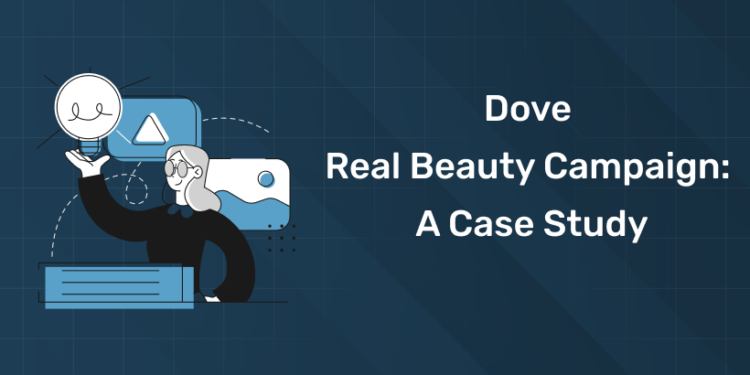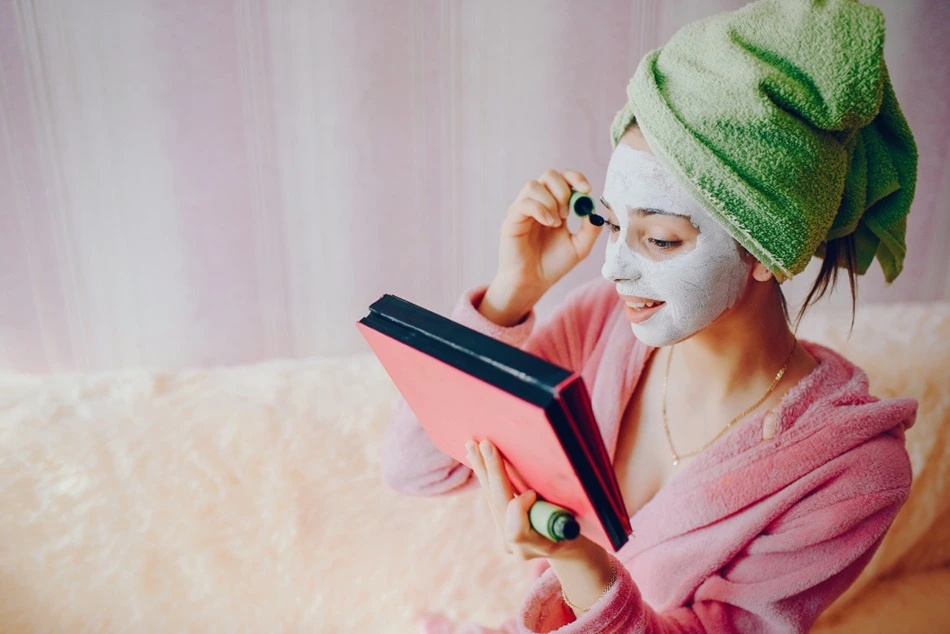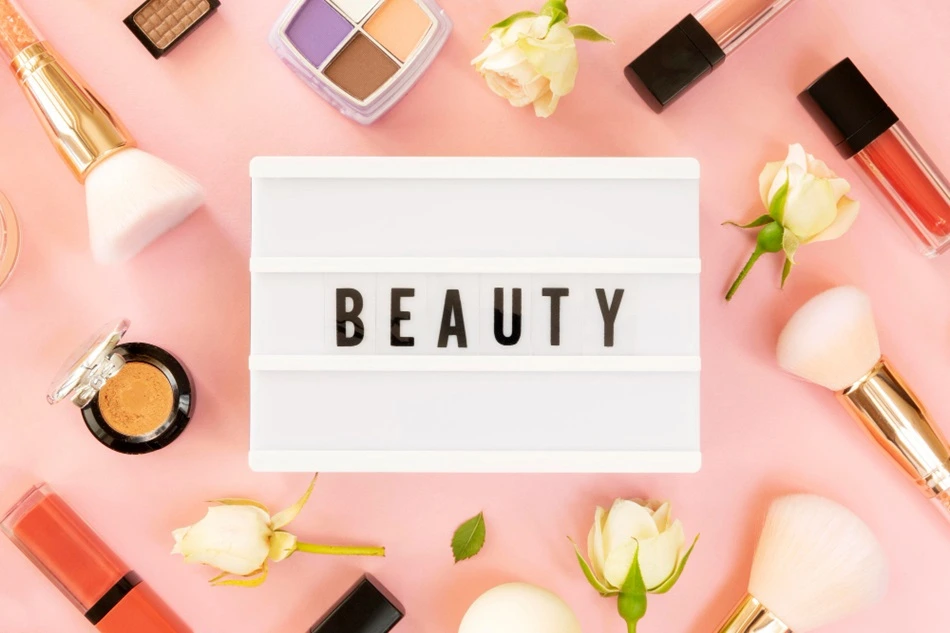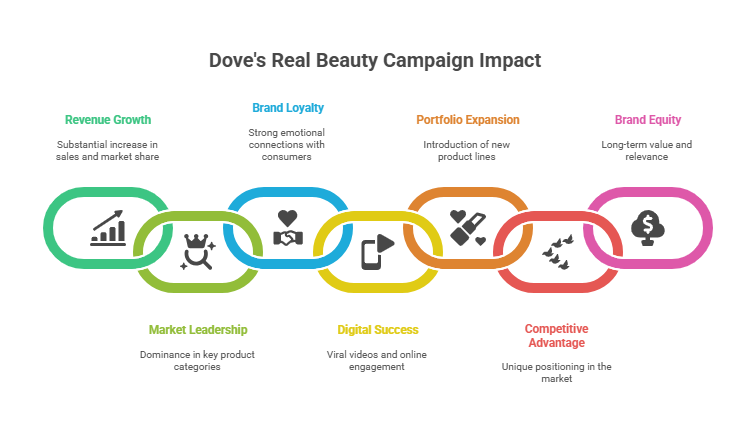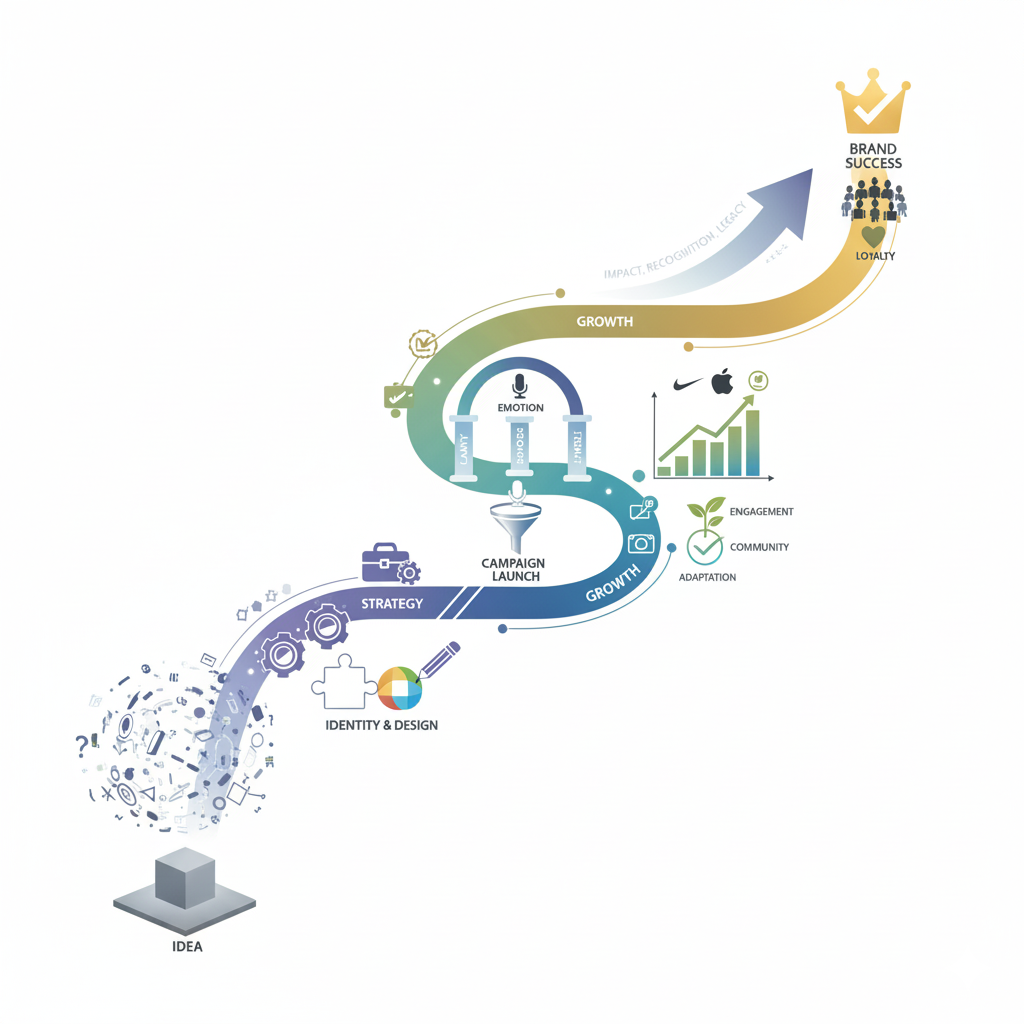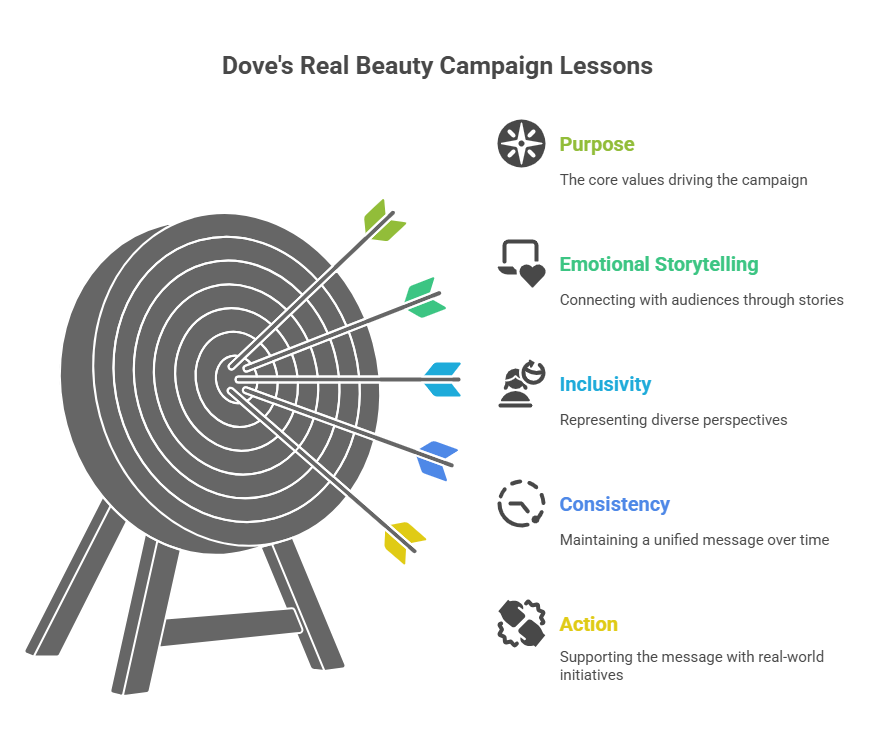Table of Contents
In a world saturated with flawless filters and unrealistic beauty standards, the Dove Real Beauty campaign disrupted the norm with a bold question: What is real beauty? This wasn’t just an advertising campaign; it was a cultural movement. Since its inception in 2004, Dove’s Real Beauty campaign has revolutionized how beauty brands communicate with women. It replaced aspirational models with authenticity, stock photos with real stories, and shallow slogans with social empowerment.
This blog explores deeper into the campaign’s origins, objectives, execution strategies, and lasting impact on both the brand and society.
Achieve exceptional results with Digital marketing techniques! Enroll Here!
Dove Real Beauty Campaign: Introduction
The Dove Real Beauty Campaign is one of the most iconic and transformative marketing initiatives in the beauty industry. Launched in 2004 by Unilever, the campaign aimed to challenge traditional beauty standards and promote self-esteem among women. With its focus on celebrating natural beauty and diversity, the campaign struck a chord with millions of people worldwide, revolutionizing the way brands connect with consumers on emotional and social issues.
This case study delves into the background, objectives, strategies, and impact of the Dove Real Beauty Campaign, providing key insights into its success and the lessons learned along the way.
Background of the Campaign
1: What is the primary goal of SEO (Search Engine Optimization)?
Dove, a personal care brand owned by Unilever, had long been associated with skin care and moisturizing products. However, by the early 2000s, the beauty industry was rife with unrealistic portrayals of women in advertisements. Most beauty campaigns featured idealized images of slim, youthful, and flawless models, creating a narrow definition of beauty that excluded the majority of women.
In response to this, Dove commissioned a global study called “The Real Truth About Beauty” in 2004. The study revealed that only 2% of women considered themselves beautiful, and a staggering 68% felt pressured by societal beauty standards. Recognizing an opportunity to address this gap, Dove launched the Real Beauty Campaign to redefine beauty and empower women to embrace their natural selves.
Become an AI-powered Digital Marketing Expert
Master AI-Driven Digital Marketing: Learn Core Skills and Tools to Lead the Industry!
Explore CourseDove Real Beauty Campaign Objectives
The Dove Real Beauty Campaign was not just a marketing strategy to promote products, it was a purpose-driven movement aimed at reshaping how beauty is perceived in society. Dove sought to go beyond conventional advertising by addressing a deeply rooted social issue: the harmful impact of unrealistic beauty standards on women’s self-esteem. The campaign was built around several key objectives that aligned with the brand’s mission to make beauty a source of confidence, not anxiety.
1. Redefine Beauty Standards
One of the primary objectives of the campaign was to challenge the narrow and unrealistic portrayal of beauty in media and advertising. Dove aimed to broaden the definition of beauty by celebrating diversity in body types, skin tones, ages, and other characteristics often overlooked by the beauty industry. The campaign sought to promote a more inclusive and authentic representation of women in media.
2. Boost Self-Esteem and Body Confidence
The campaign was designed to address the growing issue of low self-esteem among women and young girls. Research conducted by Dove revealed that the majority of women feel dissatisfied with their appearance due to societal pressures. The campaign aimed to combat these negative influences by encouraging women to appreciate their natural beauty and feel confident in their own skin.
3. Drive Emotional Connection with the Brand
By addressing a socially relevant issue, Dove sought to create a deeper emotional connection with its audience. The campaign’s focus on real women, authentic stories, and body positivity allowed Dove to position itself as a brand that genuinely cares about its consumers’ well-being. This emotional resonance helped the brand stand out in a crowded beauty market and foster long-term loyalty.
4. Create Meaningful Conversations about Beauty
Another key objective was to spark conversations around beauty and self-esteem on a global scale. Dove wanted to shift the narrative from external beauty to inner confidence, encouraging women to embrace their unique features. The campaign used storytelling and thought-provoking content to inspire discussions about societal beauty pressures and their impact on self-worth.
5. Strengthen Brand Positioning as a Purpose-Driven Company
In a competitive beauty industry, Dove aimed to differentiate itself from other brands by embracing a higher purpose. The campaign’s focus on empowering women and promoting positive change reinforced Dove’s image as a socially responsible brand that values its customers’ emotional and mental well-being. This purpose-driven approach helped build trust and credibility with consumers.
6. Increase Brand Engagement and Loyalty
Dove’s ultimate goal was to create a campaign that resonated so deeply with its audience that it would lead to higher engagement and brand loyalty. By addressing a real issue that impacted millions of women, Dove sought to become more than just a beauty brand, it aimed to be a trusted advocate for women’s empowerment and self-esteem.
Key Features of the Campaign
The Dove Real Beauty Campaign stood out for its innovative approach to marketing, focusing on authenticity, diversity, and purpose-driven storytelling. Unlike traditional beauty campaigns that relied on idealized images of models, Dove’s campaign featured real women and addressed the emotional and psychological impact of beauty standards on self-esteem. Below are the key features that made the campaign groundbreaking and impactful:
1. Use of Real Women Instead of Models
One of the most defining aspects of the Dove Real Beauty Campaign was its decision to feature real women instead of professional models. The campaign showcased women of various ages, body types, ethnicities, and appearances, emphasizing that beauty comes in all shapes, sizes, and forms. This approach resonated with audiences who had long felt excluded from the narrow definitions of beauty portrayed in mainstream media.
For example, in Dove’s “Real Women” billboard campaign, women were photographed with minimal makeup and without airbrushing. The images were accompanied by thought-provoking questions such as “Wrinkled or Wonderful?” and “Gray or Gorgeous?”, challenging viewers to rethink their perceptions of beauty.
2. Focus on Body Positivity and Self-Esteem
The campaign centered on promoting body positivity and encouraging women to embrace their natural beauty. Dove’s messaging aimed to shift the focus from physical perfection to inner confidence, helping women feel more comfortable in their own skin.
Dove extended this focus by launching the Dove Self-Esteem Project, an initiative that provided resources, workshops, and programs to help young people develop a healthy body image. This educational aspect set the campaign apart by addressing the root cause of low self-esteem and empowering future generations to challenge beauty stereotypes.
3. Empathy-Driven Storytelling
At the heart of the campaign was empathy-driven storytelling that focused on the emotional journeys of real women. One of the most iconic examples is the “Real Beauty Sketches” video, released in 2013. In this video, a forensic sketch artist created two portraits of the same woman: one based on her own description and another based on a stranger’s description. The stark difference between the two sketches highlighted how women often perceive themselves more negatively than others do.
This video became one of the most viewed online ads of all time, demonstrating the power of emotional storytelling to engage audiences on a deeper level.
4. Interactive and Participatory Campaigns
Dove made the campaign interactive by encouraging audience participation. Through social media initiatives like #RealBeauty and #NoLikesNeeded, Dove invited women to share their own stories and experiences with beauty. This interactive approach helped the brand foster a sense of community and build a movement around body positivity.
Dove also engaged in live events, workshops, and self-esteem programs to reach women and girls directly. These initiatives included sessions in schools and communities aimed at raising awareness about the impact of beauty standards on mental health.
5. Diverse and Inclusive Representation
The campaign emphasized diversity and inclusion by featuring women of different ethnicities, ages, body sizes, and abilities. Dove aimed to represent a more realistic and inclusive portrayal of beauty, challenging the traditional media narrative that often excluded marginalized groups.
For instance, Dove’s advertisements included older women, women with disabilities, and women with different skin tones and hair textures. This diverse representation sent a powerful message that beauty is not limited to a single standard.
6. Digital and Social Media Amplification
Dove effectively leveraged digital platforms and social media to amplify its message and reach a global audience. The campaign’s videos, such as “Real Beauty Sketches,” went viral on platforms like YouTube and Facebook, gaining millions of views and shares.
By using social media hashtags like #RealBeauty, Dove encouraged conversations about beauty standards and self-esteem. The brand also partnered with influencers and advocates to spread its message and engage with communities on a more personal level.
7. Consistent Messaging Across Multiple Campaigns
The success of the Dove Real Beauty Campaign can be attributed to its consistent messaging over time. Rather than a one-off marketing stunt, Dove continued to build on its core message of self-acceptance through various campaigns and initiatives.
Some of the notable extensions of the campaign include:
- “Evolution” (2006): A viral video that showed how heavily photoshopped images of models create unrealistic beauty standards.
- “Real Beauty Sketches” (2013): Highlighting the contrast between how women see themselves and how others see them.
- “Choose Beautiful” (2015): Encouraging women to see themselves as beautiful by confronting their self-perceptions.
This consistency reinforced Dove’s brand identity and ensured that the campaign’s message remained relevant and impactful over time.
8. Minimal Use of Photoshop and Airbrushing
Dove made a conscious decision to avoid photoshopping or airbrushing the images of the women featured in its ads. By showing women as they truly are, with wrinkles, stretch marks, and natural imperfections, Dove sent a powerful message that real beauty is unfiltered.
This approach stood in stark contrast to the heavily edited images commonly used in beauty advertising and was praised for its authenticity.
Master Digital Marketing at the comfort of your home! Get Free Demo Classes Here!
Execution and Strategies
The success of the Dove Real Beauty Campaign can be attributed to its thoughtful execution and strategic approach to challenging conventional beauty norms. Dove didn’t rely on a one-size-fits-all advertising strategy but instead employed a variety of creative tactics and channels to spread its message. The brand leveraged emotional storytelling, digital marketing, interactive initiatives, and partnerships to amplify the campaign’s impact across the globe. Here’s a closer look at the key strategies Dove used to execute the campaign and make it a long-lasting movement.
1. Multi-Channel Marketing Approach
Dove executed the campaign through a multi-channel marketing strategy that included traditional media, digital platforms, and on-ground initiatives. By utilizing TV ads, print ads, billboards, and social media, Dove ensured its message reached a diverse and global audience.
- Television Ads: Dove launched TV commercials that featured real women instead of models, showing them confidently embracing their natural beauty.
- Billboards: The brand’s outdoor advertisements sparked conversations by featuring women with different body types and asking thought-provoking questions such as “Oversized or Outstanding?”
- Social Media: Digital platforms like YouTube, Facebook, and Instagram played a crucial role in amplifying the campaign’s reach, making Dove’s message go viral.
This multi-channel approach allowed Dove to create a consistent and impactful message across various touchpoints, ensuring the campaign stayed in the public eye.
2. Storytelling Through Emotional Content
Dove’s strategy was rooted in empathy-driven storytelling that connected with audiences on a deeply emotional level. The brand produced a series of videos and content pieces that highlighted real women’s experiences with self-esteem and body image issues.
One of the most iconic pieces of content was the “Real Beauty Sketches” video, launched in 2013. The video featured a forensic artist drawing two portraits of women: one based on their own descriptions and another based on a stranger’s description. The difference between the two sketches revealed how women often see themselves more negatively than others do. This video became one of the most-watched online ads, garnering over 180 million views.
Another powerful storytelling initiative was the “Evolution” video, which showcased how a model’s image is drastically altered through makeup, lighting, and Photoshop before appearing in advertisements. This video exposed the unrealistic beauty standards perpetuated by the media.
3. Digital and Social Media Strategies
Dove capitalized on the rise of social media to spread its message and engage with its audience in real-time. The brand encouraged women to participate in the campaign by sharing their own stories and experiences with beauty and self-esteem.
Key digital strategies included:
- Hashtag Campaigns: Dove launched several hashtag campaigns, including #RealBeauty and #NoLikesNeeded, to spark conversations on social media about body positivity and natural beauty.
- User-Generated Content: Dove invited women to share photos and videos celebrating their natural beauty, creating a sense of community and inclusivity.
- Influencer Partnerships: Dove collaborated with influencers, advocates, and thought leaders who aligned with the brand’s message, helping to amplify its reach and credibility.
By using social media, Dove was able to turn its campaign into a global movement that resonated across different cultures and demographics.
4. Real Women as Brand Ambassadors
Dove’s decision to feature real women instead of professional models was a game-changer. The campaign showcased women from diverse backgrounds, ages, and body types, breaking the mold of traditional beauty advertising.
The brand held casting calls for everyday women to appear in their advertisements, giving the campaign an authentic and relatable feel. These women became the face of Dove’s mission to redefine beauty, making the brand’s message more credible and impactful.
In one campaign, Dove featured six real women in a billboard ad that challenged viewers to rethink beauty standards. The ad asked questions like “Wrinkled or Wonderful?” and “Flawed or Flawless?”, encouraging audiences to embrace their unique features.
5. Educational Initiatives: Dove Self-Esteem Project
To make a lasting impact, Dove extended the campaign beyond advertising by launching the Dove Self-Esteem Project. This initiative aimed to educate young people about body image and self-confidence through workshops, resources, and programs.
Key components of the Self-Esteem Project included:
- School Workshops: Dove partnered with schools to run workshops that taught students about the dangers of beauty stereotypes and the importance of self-acceptance.
- Online Resources: The brand created free online tools and guides for parents, teachers, and mentors to help young people build self-esteem.
- Community Programs: Dove worked with local communities to raise awareness about body positivity and promote mental health in relation to beauty standards.
By focusing on education, Dove positioned itself as a brand that cares about the well-being of its audience beyond product sales.
6. Consistency in Messaging Across Campaigns
Dove’s execution strategy focused on consistent messaging across all its campaigns and initiatives. The brand ensured that each piece of content reinforced its core message: beauty is diverse, and every woman should feel confident in her own skin.
Over the years, Dove launched several extensions of the Real Beauty Campaign, including:
- “Choose Beautiful” (2015): Women were given the choice to walk through a door labeled “Beautiful” or “Average.” The campaign highlighted how self-perception affects confidence and encouraged women to see themselves as beautiful.
- “No Digital Distortion” (2018): Dove committed to banning all digitally retouched images from its advertisements, reinforcing its message of natural beauty.
- “Reverse Selfie” (2021): This campaign focused on the harmful effects of social media filters on self-esteem, particularly among young people.
The consistency in messaging helped Dove build trust with its audience and maintain relevance in an ever-evolving beauty industry.
7. Strategic Partnerships and Collaborations
Dove partnered with organizations and influencers to further amplify its message and reach wider audiences. Collaborations with advocacy groups focused on mental health, body positivity, and women’s rights helped Dove establish itself as a credible advocate for change.
Some notable partnerships included:
- The World Association of Girl Guides and Girl Scouts: Dove collaborated with this organization to create programs aimed at boosting self-esteem among young girls.
- Mental Health Foundations: Dove worked with mental health charities to address the psychological impact of beauty pressures.
These partnerships strengthened Dove’s reputation as a socially responsible brand.
Achieve exceptional results with Digital marketing techniques! Enroll Here!
Become an AI-powered Digital Marketing Expert
Master AI-Driven Digital Marketing: Learn Core Skills and Tools to Lead the Industry!
Explore CourseImpact and Reception
The Dove Real Beauty Campaign had a profound impact on both the beauty industry and society at large. Its revolutionary approach to promoting body positivity and redefining beauty standards resonated deeply with consumers around the world. By celebrating diversity and authenticity, Dove inspired millions of women to embrace their natural beauty and fostered meaningful conversations about self-esteem and body image. However, while the campaign was widely praised, it also faced criticism and sparked debates about the brand’s authenticity and consistency. Below is a breakdown of the campaign’s cultural, social, and business impact, as well as the public’s reception.
1. Cultural and Social Impact
The Dove Real Beauty Campaign played a key role in shifting societal perceptions of beauty and sparking a broader movement toward body positivity. At a time when media and advertising perpetuated narrow beauty ideals, Dove’s campaign encouraged people to rethink what it means to be beautiful.
Key Social Impacts:
- Challenging Beauty Norms: The campaign challenged the long-standing portrayal of beauty as young, thin, and flawless, promoting the idea that beauty comes in all shapes, sizes, ages, and ethnicities.
- Body Positivity Movement: Dove became one of the early advocates of the body positivity movement, helping to pave the way for more inclusive representation in media and advertising.
- Raising Self-Esteem: Through the Dove Self-Esteem Project, the campaign reached millions of young people with educational programs designed to boost self-esteem and promote healthy body image.
The “Real Beauty Sketches” video, in particular, had a profound social impact by highlighting how women often see themselves in a more negative light than others do. The video went viral, becoming one of the most-watched online ads of all time, with over 180 million views in its first month. It sparked emotional responses from viewers and prompted women to reflect on their own self-perceptions.
2. Business Impact
The campaign’s success translated into significant business outcomes for Dove. By aligning itself with a socially relevant cause, the brand strengthened its emotional connection with consumers and positioned itself as a purpose-driven company.
Key Business Outcomes:
- Sales Growth: The campaign led to a substantial increase in Dove’s sales, with the brand’s revenue growing from $2.5 billion to $4 billion within the first ten years of the campaign.
- Market Leadership: Dove became a market leader in the personal care industry, particularly in categories like body wash, soap, and moisturizing products.
- Brand Loyalty: The campaign fostered long-term brand loyalty, as consumers appreciated Dove’s commitment to promoting positive social change.
The campaign also set a benchmark for purpose-driven marketing, inspiring other brands to adopt social causes in their advertising strategies. Companies like Nike, Always, and Pantene followed suit with campaigns focused on inclusivity, confidence, and empowerment.
3. Media Recognition and Awards
The Dove Real Beauty Campaign received widespread media coverage and was celebrated as one of the most innovative marketing campaigns of its time. It won numerous awards for its creativity and impact, including the prestigious Cannes Lions Grand Prix.
Notable Awards and Recognitions:
- Cannes Lions Grand Prix (2007)
- Effie Awards for Marketing Effectiveness
- Advertising Age’s Top Campaigns of the 21st Century
The campaign’s success also earned Dove a reputation as a trailblazer in cause marketing, making it a case study in business schools and marketing conferences around the world.
4. Public Reception
The public reception of the Dove Real Beauty Campaign was overwhelmingly positive, with many praising the brand for promoting inclusivity and challenging harmful beauty stereotypes. The campaign resonated deeply with women who had long felt excluded by traditional beauty standards.
Positive Responses:
- Many women felt represented and empowered by Dove’s campaign, which celebrated natural beauty and diversity.
- The campaign’s messaging inspired emotional connections with consumers, who appreciated the brand’s commitment to promoting self-esteem and confidence.
- The “Real Beauty Sketches” video became an emotional touchpoint, with many viewers sharing personal stories about their struggles with body image.
However, despite the praise, the campaign also faced criticism and skepticism.
5. Criticism and Controversy
While the Dove Real Beauty Campaign was widely celebrated, it was not without controversy. Some critics questioned the authenticity of Dove’s messaging and highlighted inconsistencies in its parent company’s practices.
Key Criticisms:
- Contradictory Branding: Critics pointed out that Dove’s parent company, Unilever, also owns brands like Axe and Fair & Lovely, which have historically promoted hyper-masculine ideals and skin-lightening products, respectively. This raised concerns about whether Dove’s message was truly genuine or just a marketing tactic.
- Photoshop Allegations: Although Dove committed to using unretouched images, there were allegations that some ads had been digitally altered. This led to accusations of hypocrisy, undermining the brand’s credibility.
- Commercial Motivations: Some skeptics argued that the campaign was a clever business move rather than a genuine social mission, questioning whether Dove’s commitment to body positivity was driven more by profit than purpose.
Despite these criticisms, Dove continued to refine its campaign and messaging to address the concerns, including initiatives like the No Digital Distortion Mark, a pledge to eliminate retouching in its advertising.
6. Long-Term Influence on the Beauty Industry
The Dove Real Beauty Campaign had a lasting impact on the beauty industry, inspiring brands to embrace more inclusive and diverse marketing practices.
Key Industry Changes:
- More brands have shifted toward authentic, unretouched imagery in their advertising.
- The campaign helped popularize the body positivity movement, which has now become a mainstream cultural phenomenon.
- There is an increasing focus on mental health and self-esteem initiatives in the beauty industry, as brands recognize the importance of promoting positive body image.
Dove’s campaign showed that consumers value authenticity and purpose-driven marketing, paving the way for other brands to take a stand on social issues.
Business Outcomes
The Dove Real Beauty Campaign delivered significant business outcomes for Dove and its parent company, Unilever, making it one of the most successful purpose-driven marketing campaigns in history. The campaign’s alignment with a social cause not only boosted Dove’s brand reputation but also translated into measurable growth in sales, market share, and customer loyalty. Below is an in-depth look at the business impact of the campaign and how it transformed Dove into a market leader.
1. Revenue Growth and Increased Sales
One of the most tangible business outcomes of the Dove Real Beauty Campaign was a substantial increase in revenue and sales.
- In the early 2000s, Dove’s annual sales stood at around $2.5 billion. After the launch of the Real Beauty Campaign, the brand experienced a steady increase in revenue, reaching $4 billion within a decade.
- The campaign attracted new customers and strengthened brand loyalty among existing ones, which helped Dove expand its market share in the personal care industry.
Dove’s success showed that purpose-driven marketing can be a powerful tool for business growth, proving that consumers respond positively to brands that take a stand on social issues.
2. Market Leadership in the Personal Care Industry
The Real Beauty Campaign helped Dove become a market leader in key product categories, particularly in body wash, soap, and moisturizing products.
- Before the campaign, Dove was competing with several other well-established personal care brands. The campaign’s message of inclusivity and self-esteem gave Dove a unique selling proposition that differentiated it from its competitors.
- The brand’s innovative approach to marketing, which included using real women in its ads and avoiding digital distortion, further solidified Dove’s position as a trusted and credible brand.
Dove’s ability to stand out in a crowded market helped it gain a loyal customer base and strengthen its long-term brand equity.
3. Stronger Brand Loyalty and Emotional Connection
The campaign fostered deep emotional connections with consumers by addressing an issue that resonated on a personal level, self-esteem and body image.
- Dove’s commitment to promoting authentic beauty created trust and loyalty among consumers, particularly women who felt empowered by the brand’s message.
- According to a study conducted by Edelman, 80% of women said Dove’s campaign made them feel more confident and 92% of women felt Dove was committed to representing real women.
This emotional connection helped Dove achieve higher customer retention rates, as consumers were more likely to support a brand that aligned with their values.
4. Digital and Viral Success
The digital component of the campaign played a significant role in its success, especially with the release of viral videos like “Real Beauty Sketches” and “Evolution.”
- The “Real Beauty Sketches” video became one of the most-watched online ads of all time, with over 180 million views within a month of its release.
- The “Evolution” video, which highlighted the excessive use of Photoshop in beauty ads, won the Cannes Lions Grand Prix and was widely shared across social media platforms.
This viral success helped Dove reach millions of people globally, amplifying its message and driving brand awareness beyond traditional advertising channels.
5. Expansion of the Dove Portfolio
The success of the campaign allowed Dove to expand its product portfolio and introduce new lines under the Real Beauty umbrella.
- Dove introduced products like Dove Men+Care, Dove Baby, and Dove DermaSeries, all of which continued the brand’s commitment to promoting authenticity and self-care.
- The Dove Self-Esteem Project also became an integral part of the brand’s identity, further solidifying its reputation as a purpose-driven company.
This product diversification helped Dove appeal to a broader demographic and strengthen its market presence in different categories.
6. Competitive Advantage
The Dove Real Beauty Campaign gave the brand a sustainable competitive advantage by creating purpose-driven differentiation.
- While other beauty brands continued to promote idealized beauty standards, Dove’s inclusive approach allowed it to stand out in the market.
- The campaign’s message of real beauty resonated so strongly with consumers that it forced competitors to rethink their marketing strategies and adopt more inclusive and authentic messaging.
By being first to market with a campaign that addressed body positivity and self-esteem, Dove set a benchmark in the beauty industry and established itself as a leader in social impact marketing.
7. Long-Term Brand Equity
The campaign’s success extended beyond short-term sales to create long-term brand equity for Dove.
- Dove became known as a purpose-driven brand that stands for more than just selling products.
- The campaign reinforced brand loyalty and helped the company weather market changes and evolving consumer expectations.
By staying committed to its core message of real beauty, Dove was able to maintain its relevance in an increasingly socially conscious market.
Stop Guessing. Start Building. Download the Proven Brand-Building Playbook
Lessons Learned
The Dove Real Beauty Campaign has become a landmark example of how purpose-driven marketing can create both social impact and business success. However, the campaign also revealed important insights about the challenges and complexities of addressing societal issues through brand messaging. Below are the key lessons learned from the Dove Real Beauty Campaign that can serve as valuable takeaways for brands aiming to engage in meaningful, socially responsible marketing.
1. Purpose-Driven Marketing Can Build Strong Emotional Connections
One of the biggest lessons from the Dove campaign is that purpose-driven marketing resonates deeply with consumers. By addressing a societal issue, the harmful impact of unrealistic beauty standards, Dove was able to create an emotional connection with its audience.
Consumers are more likely to engage with brands that align with their values and take a stand on important issues. Dove’s campaign proved that when brands focus on meaningful storytelling and real-life challenges, they can foster long-term loyalty and brand trust.
2. Authenticity is Crucial for Success
A key reason why Dove’s campaign resonated was its authentic approach. By featuring real women of different ages, body types, and ethnicities, the brand presented a relatable and realistic image of beauty that audiences could identify with.
However, authenticity must be consistent across all brand activities. Dove faced criticism for inconsistencies between its messaging and the practices of its parent company, Unilever, which owns other brands like Axe and Fair & Lovely that promote traditional beauty ideals. This perceived hypocrisy led some consumers to question Dove’s sincerity.
3. Social Issues Require Long-Term Commitment
The Dove Real Beauty Campaign showed that addressing social issues is not a one-off marketing stunt. To make a lasting impact, brands must commit to the cause over the long term.
Dove’s sustained efforts, such as the Dove Self-Esteem Project, workshops, and educational resources, demonstrated its ongoing commitment to promoting body positivity and improving self-esteem. This long-term focus helped reinforce the brand’s message and maintain its relevance over the years.
4. Emotional Storytelling is a Powerful Tool
One of the most effective elements of the Dove campaign was its use of emotional storytelling to create high-impact content. Campaigns like “Real Beauty Sketches” and “Evolution” struck an emotional chord with audiences by highlighting real-life struggles with self-esteem and body image.
The success of these videos demonstrated the power of relatable and empathetic stories to drive engagement and inspire meaningful conversations. Dove’s ability to create viral content with emotional appeal helped the brand reach millions of people globally.
5. Diversity and Inclusion are Non-Negotiable
Dove’s campaign showed that diversity and inclusion are critical in today’s marketing landscape. The campaign’s focus on showcasing women of different ethnicities, body types, and ages. It challenged traditional beauty norms and made many consumers feel seen and represented.
However, true diversity goes beyond just featuring diverse faces in ads. It also requires brands to embed inclusivity into their organizational culture and ensure that all marketing efforts reflect diverse perspectives.
6. Social Media Amplifies Impact
The Dove Real Beauty Campaign highlighted the power of social media in spreading a brand’s message and engaging audiences. Videos like “Real Beauty Sketches” became viral hits on platforms like YouTube and Facebook, allowing Dove to reach millions of people across the globe.
Social media also provided a platform for interactive campaigns where consumers could share their own stories and experiences, creating a sense of community and belonging.
7. Purpose Alone is Not Enough, Execution Matters
While having a social purpose is important, the execution of a campaign is equally critical. Dove’s campaign succeeded because it was well-executed, with thoughtful content, emotional storytelling, and a multi-channel approach that ensured consistent messaging across all platforms.
However, the campaign also faced backlash when perceived inconsistencies in Dove’s actions and its parent company’s practices came to light. This highlighted the importance of ensuring alignment between a brand’s purpose and its business operations.
8. Be Prepared for Criticism
No matter how well-intentioned a campaign is, it’s likely to face criticism. Dove’s campaign was praised for its positive message, but it also faced scrutiny for perceived contradictions and accusations of hypocrisy.
Brands need to be prepared to address criticism head-on and adapt their strategies to stay true to their values while learning from feedback.
Challenges and Future Directions
While the Dove Real Beauty Campaign was largely successful, it faced challenges:
1. Authenticity vs. Commercialization
While the Dove Real Beauty Campaign received widespread praise for challenging traditional beauty norms, it also faced significant scrutiny. Critics questioned whether Dove’s commitment to redefining beauty was genuine or simply a calculated marketing tactic to sell products. These criticisms were amplified by the fact that Dove is part of Unilever, a parent company that also owns brands like Axe and Fair & Lovely (now Glow & Lovely), which have been accused of promoting hyper-masculine stereotypes or traditional beauty ideals.
The juxtaposition of Dove’s empowerment-focused messaging with the contrasting narratives of its sibling brands led to skepticism about the sincerity of its mission. This inconsistency raised concerns that the campaign might prioritize profit over purpose, potentially undermining its credibility among socially conscious consumers.
2. Staying Relevant in a Changing Society
Dove’s success hinges on its ability to stay attuned to societal shifts in how beauty is perceived. However, as conversations about inclusivity and representation become more nuanced, the brand faces the challenge of evolving its messaging to reflect these changes. For instance:
- The rise of gender inclusivity and non-binary identities requires Dove to rethink its campaigns to ensure they resonate with a broader spectrum of individuals.
- The growing impact of digital trends, such as the use of social media filters and photo editing, has created new insecurities that need to be addressed.
Failing to keep up with these changes risks making the brand appear outdated or disconnected from the audience it seeks to empower.
Future Directions for Dove
1. Tackling Social Media and Digital Beauty Standards
With the increasing influence of social media, beauty standards are now being shaped by filters, augmented reality apps, and heavily edited photos. Dove has the opportunity to address the negative effects of these trends on self-esteem, particularly among young audiences. Future campaigns could focus on:
- Education: Highlighting the unrealistic nature of social media beauty standards through partnerships with influencers and awareness campaigns.
- Tools for Empowerment: Offering resources or platforms that teach individuals to embrace unfiltered, authentic versions of themselves.
By leading the conversation on digital beauty, Dove can further solidify its role as a champion of real beauty and self-confidence.
2. Expanding Inclusivity Across All Dimensions
To maintain its relevance, Dove should deepen its focus on inclusivity. While the Real Beauty Campaign already challenged conventional beauty standards, future campaigns could go further by spotlighting:
- Diverse Genders: Including individuals across the gender spectrum to reflect a more inclusive definition of beauty.
- Age Inclusivity: Representing older individuals and emphasizing beauty at every stage of life.
- Abilities: Featuring people with visible and invisible disabilities to normalize and celebrate their beauty.
Such efforts would not only reinforce Dove’s message of “real beauty” but also expand its resonance to previously underrepresented groups.
3. Strengthening Community Impact through Self-Esteem Programs
Dove’s self-esteem initiatives have been a vital part of its mission, but there is room to deepen their impact:
- School Collaborations: Partner with educational institutions to integrate self-esteem workshops into school curriculums, reaching young individuals at critical developmental stages.
- Localized Programs: Tailor programs to address specific beauty challenges in different cultures or regions, making the initiatives more relevant globally.
- Digital Resources: Leverage technology to create scalable, accessible tools like self-esteem apps, virtual workshops, or online communities where individuals can share stories and support each other.
By focusing on grassroots efforts that leave a lasting mark on communities, Dove can align its purpose with tangible social change.
4. Partnering with Purpose-Driven Influencers and Activists
Future campaigns could collaborate with influencers and activists who align with Dove’s core mission of redefining beauty. These partnerships would amplify the brand’s message while also lending it credibility. Dove should prioritize working with individuals who authentically represent its values. It include things such as those advocating for inclusivity, mental health, and body positivity.
5. Emphasizing Sustainability and Ethical Practices
To build trust and align with consumer priorities, Dove should strengthen its focus on sustainability and ethical practices.
- Eco-Friendly Packaging: Transition to completely recyclable or biodegradable packaging to minimize environmental impact.
- Clean Beauty: Ensure that products are free of harmful chemicals and align with the growing demand for clean, cruelty-free beauty products.
Integrating sustainability into its brand identity would demonstrate Dove’s commitment not only to societal well-being but also to environmental stewardship.
Dove Real Beauty Campaign: Conclusion
The Dove Real Beauty Campaign remains a landmark example of purpose-driven marketing that reshaped societal perceptions of beauty. By challenging conventional beauty standards and promoting self-confidence, Dove created a campaign that resonated deeply with consumers and delivered impressive business results.
Despite facing criticism and challenges, the campaign’s core message of embracing natural beauty continues to inspire brands and individuals alike. As the beauty industry evolves, Dove’s Real Beauty Campaign serves as a reminder that marketing can be a powerful force for social change.
Frequently Asked Questions
What is the Dove Real Beauty Campaign?
The Dove Real Beauty Campaign is a global marketing initiative launched by Dove in 2004 to challenge traditional beauty standards and promote a more inclusive definition of beauty. It celebrates women of all shapes, sizes, ages, and ethnicities, encouraging self-confidence and authenticity.
Why was the Dove Real Beauty Campaign created?
The campaign was created in response to research indicating that only a small percentage of women felt confident about their appearance. Dove aimed to challenge unrealistic beauty standards perpetuated by the media and promote a healthier, more inclusive perception of beauty.
What made the Dove Real Beauty Campaign successful?
The campaign resonated with audiences because it tapped into real issues, such as body image and self-esteem. Its focus on authenticity, emotional storytelling, and diverse representation helped Dove build a strong emotional connection with consumers, resulting in increased brand loyalty and sales.
What challenges did the Dove Real Beauty Campaign face?
Some of the challenges included:
- Authenticity vs. Commercialization: Critics questioned whether Dove’s messaging was sincere or just a marketing tactic, especially given Unilever’s ownership of other brands that promoted traditional beauty ideals.
- Staying Relevant: As societal beauty standards evolved, Dove needed to ensure its messaging remained fresh and impactful.
How did Dove address criticism of its campaign?
Dove responded to criticism by emphasizing its long-term commitment to addressing beauty-related issues through initiatives like the Dove Self-Esteem Project. It also made efforts to promote inclusivity and authenticity in subsequent campaigns.
What is the Dove Self-Esteem Project?
The Dove Self-Esteem Project is a global initiative launched by Dove to improve self-esteem and body confidence among young people. It offers educational resources, workshops, and programs to help individuals develop a positive relationship with their appearance.
How has the Dove Real Beauty Campaign evolved over time?
Over the years, Dove has expanded its campaign to address emerging issues, such as the impact of social media on self-esteem. It has also included more diverse representation across gender, age, abilities, and ethnicities in its advertisements to stay relevant and inclusive.
What lessons can brands learn from the Dove Real Beauty Campaign?
Brands can learn the importance of:
- Connecting with audiences through authentic and relatable storytelling.
- Addressing real societal issues to build trust and loyalty.
- Staying consistent with their messaging while evolving to reflect changing cultural norms.
How has the campaign impacted the beauty industry?
The Dove Real Beauty Campaign has been a game-changer in the beauty industry. It inspired other brands to adopt more inclusive and body-positive messaging, contributing to a shift in how beauty is represented in advertising and media.
What’s next for Dove and the Real Beauty Campaign?
To remain a leader in purpose-driven marketing, Dove is expected to focus on issues like the impact of social media filters, expand inclusivity across genders and abilities, and strengthen its sustainability and self-esteem programs.


